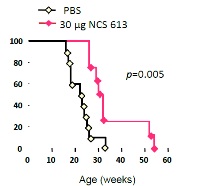
Claire Lugnier
CNRS, France
Title: Cyclic nucleotide phosphodiesterase (PDE) implication in lupus erythematosus: Effect of a new PDE4 inhibitor
Biography
Biography: Claire Lugnier
Abstract
Lupus erythematosus is a multigenic inflammatory autoimmune disease that is usually treated with corticoids, anti-TNFα compounds, and anti- CD20, by acting non-selectively, inducing unwanted effects. Cyclic nucleotide phosphodiesterases (PDEs) play a major role in intracellular signaling by hydrolyzing the second messenger cyclic AMP and/or cyclic GMP, according to their subtypes. Since PDE is able to modulate inflammatory processes such as TNFα and other cytokines, one could wonder whether a PDE inhibitor might be beneficial in lupus treatment. Therefore, the evolution of PDE activity and expression levels during the course of the disease in MRL/lpr lupus-prone mice, as well as the biological and the clinical effects of treatments with three different PDE inhibitors: pentoxifylline (100µg), denbufylline (100µg) and NCS 613 (30µg) was evaluated in these mice. The comparison of kidney PDE4 activity progression of MRL/lpr mice with CBA/J control mice reveals an increase of activity with the disease progression, whereas PDE2 and PDE3 activities are not significantly changed. When treated with PDE inhibitors, the most potent and selective PDE4 inhibitor NCS 613 (IC50=42 nM) was also found to be the most effective molecule in decreasing proteinuria and increasing survival rate of MRL/lpr mice. NCS 613 is a potent inhibitor which is more selective for PDE4C subtype (IC50: 1.4 nM) and has an affinity for the high affinity rolipram binding site (HARBS) and relatively low (Ki=148 nM) in comparison to rolipram (Ki=3 nM) suggesting few emetic effect. Interestingly, NCS 613 inhibits basal and LPS-induced TNFa secretion from PBLs of lupus patients, as well as from MRL/lpr peripheral blood lymphocytes (PBLs), pointing out the therapeutic potential of NCS 613 in systemic lupus. This study reveals that PDE4 represent a potential therapeutic target in lupus disease and that the original compound NCS 613 delay lupus disease progression.

References:
1. Keravis T, Lugnier C (2012) Cyclic nucleotide phosphodiesterase (PDE) isozymes as targets of the intracellular signalling network: Benefits of PDE inhibitors in various diseases and perspectives for future therapeutic developments. Br J Pharmacol 165(5):1288- 305.
2. T, Monneaux F, Yougbare I, Gazi L, Bourguignon Jj, Muller S, Lugnier C (2012) Disease Progression in MRL/lpr Lupus-Prone Mice is Reduced by NCS 613, a Specific Cyclic Nucleotide Phosphodiesterase type 4 (PDE4) Inhibitor. Plos One (2012) 7 (1): e28899.
3. Yougbaré I, Boire G, Roy M, Lugnier C, Rousseau E (2013) NCS 613 exhibits anti-inflammatory effects on PBMC from lupus patients by inhibiting p38 MAPK and NFκB signalling pathways while reducing pro-inflammatory cytokine production. Can J Physiol Pharmacol 91(5) :353-61.
4. Boichot E, Wallace,JL, Germain N, Corbel M, Lugnier C., Lagente V, Bourguignon, JJ (2000) Anti-inflammatory activities of a new series of selective phosphodiesterase 4 inhibitors derived from 9- benzyladenine. J. Pharmacol. Exp. Ther. 292, 647-653
5. Bourguignon, JJ, Desaubry L, Raboisson P, Wermuth CG, Lugnier C (1997) 9-benzyladenines: potent and selective cAMP phosphodiesterase inhibitors. J. Med. Chem.) 40, 1768-1770.
